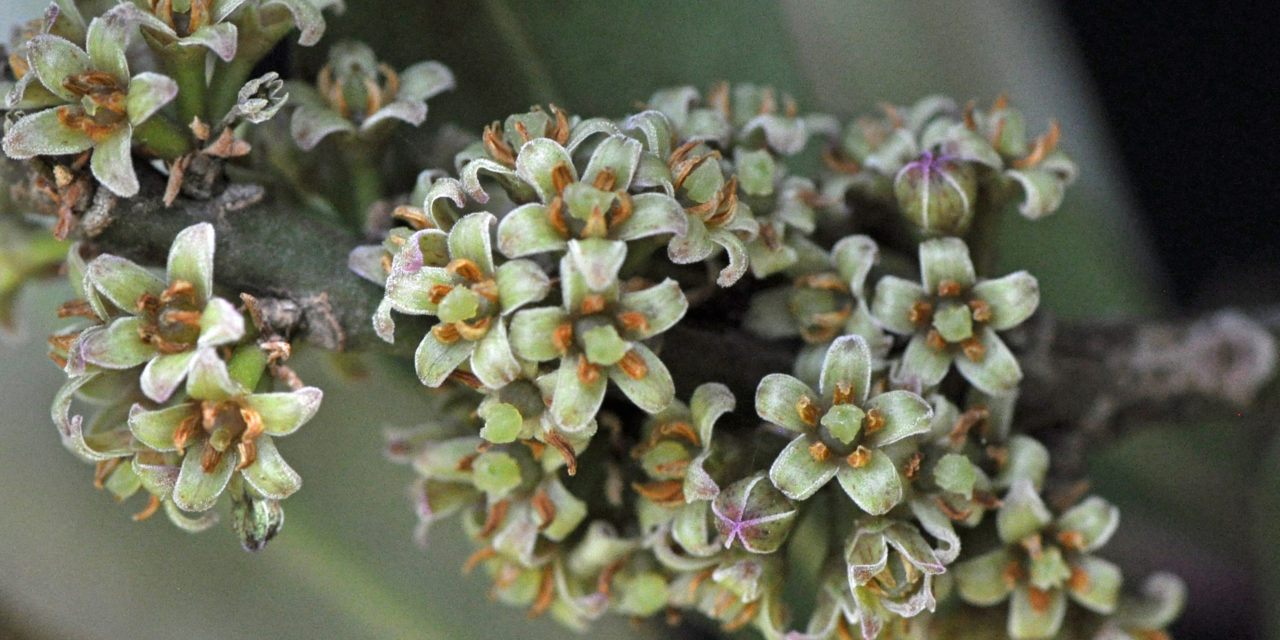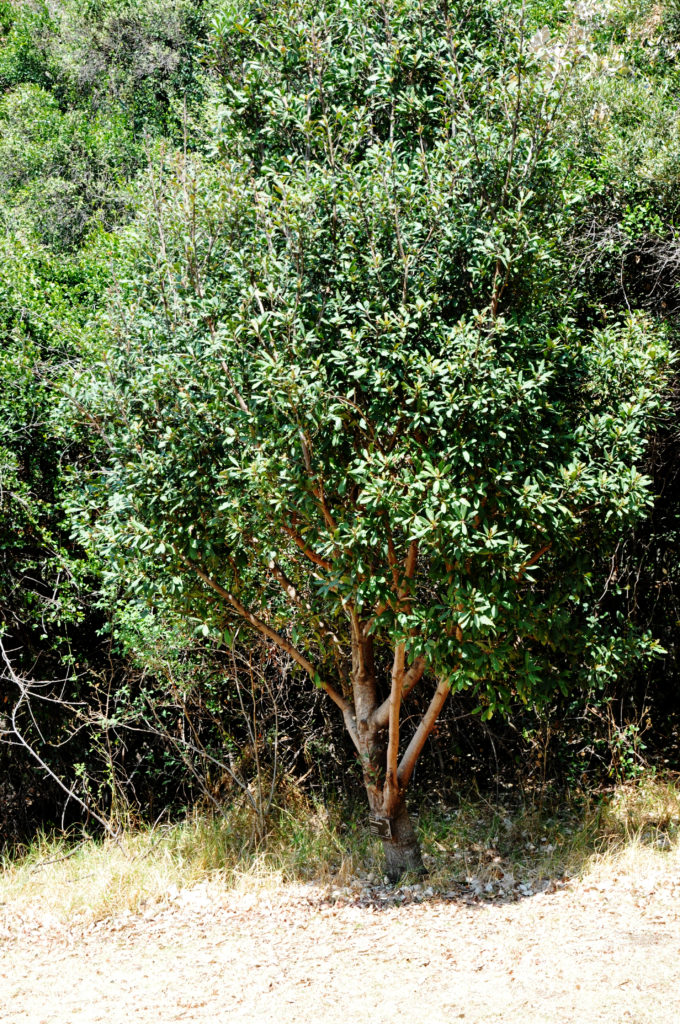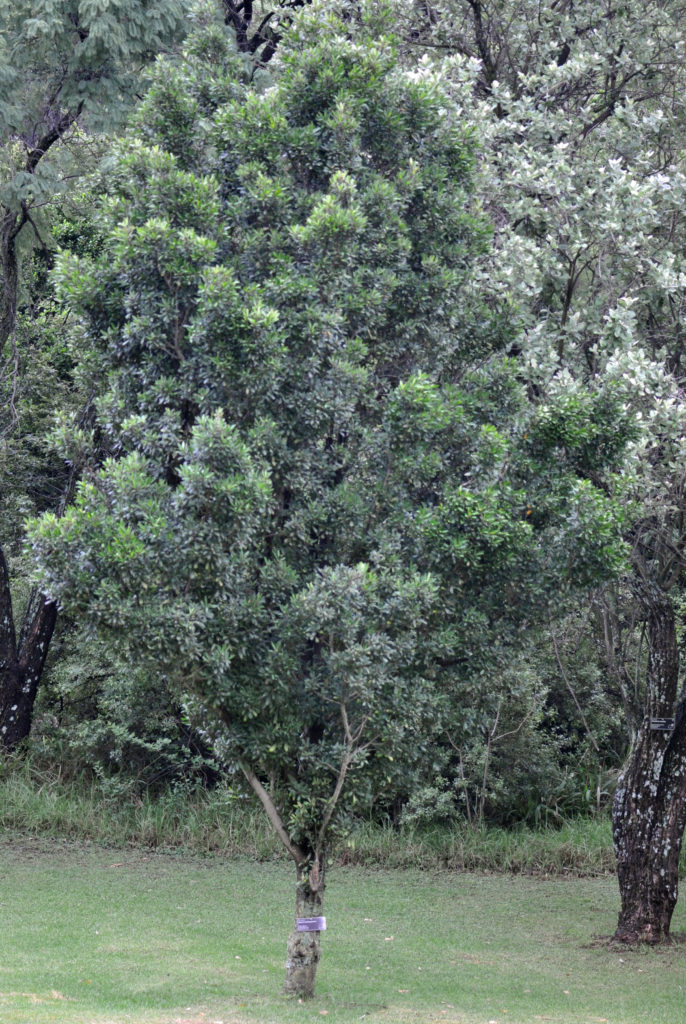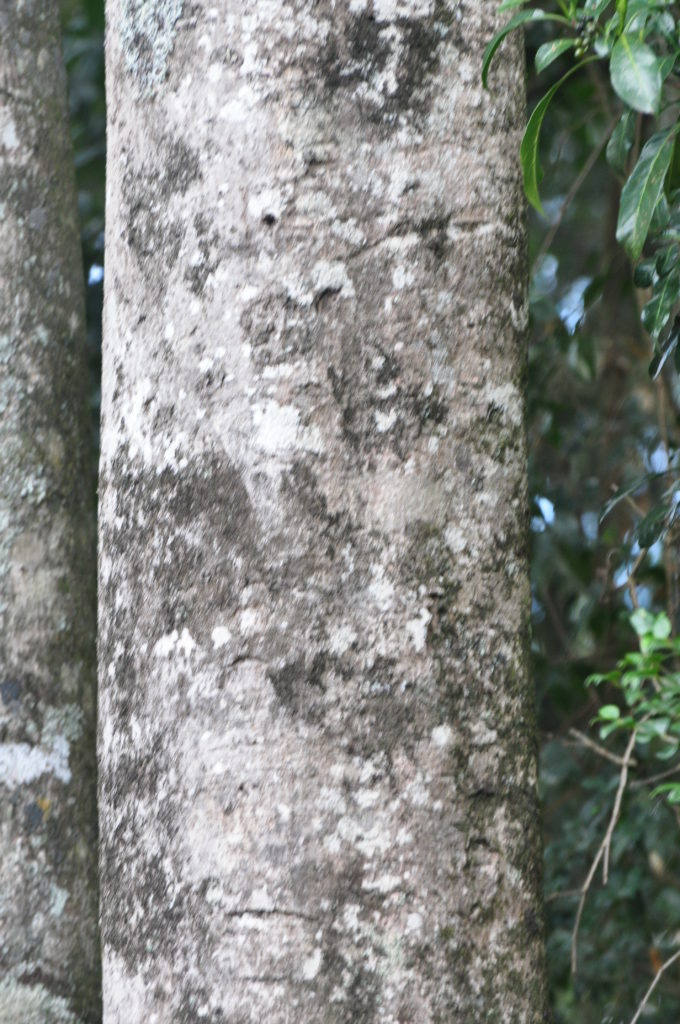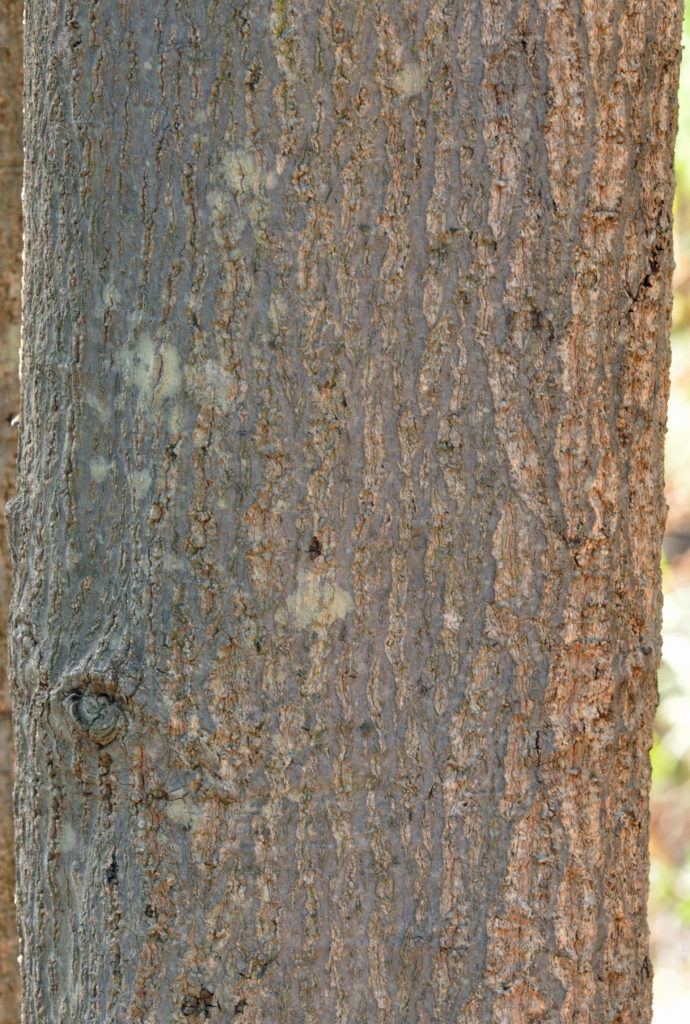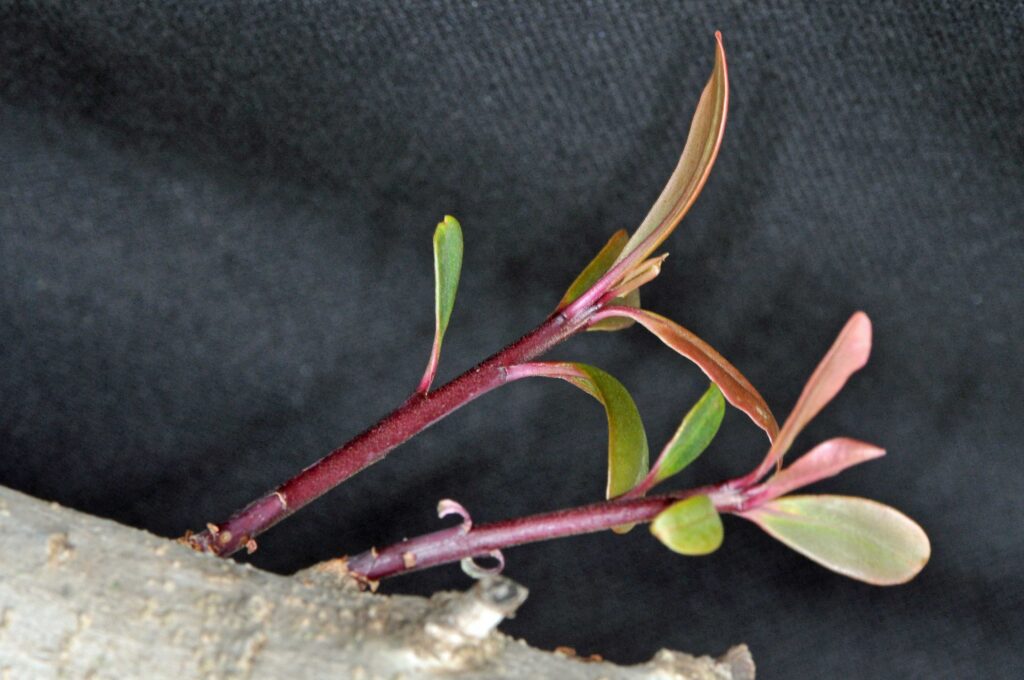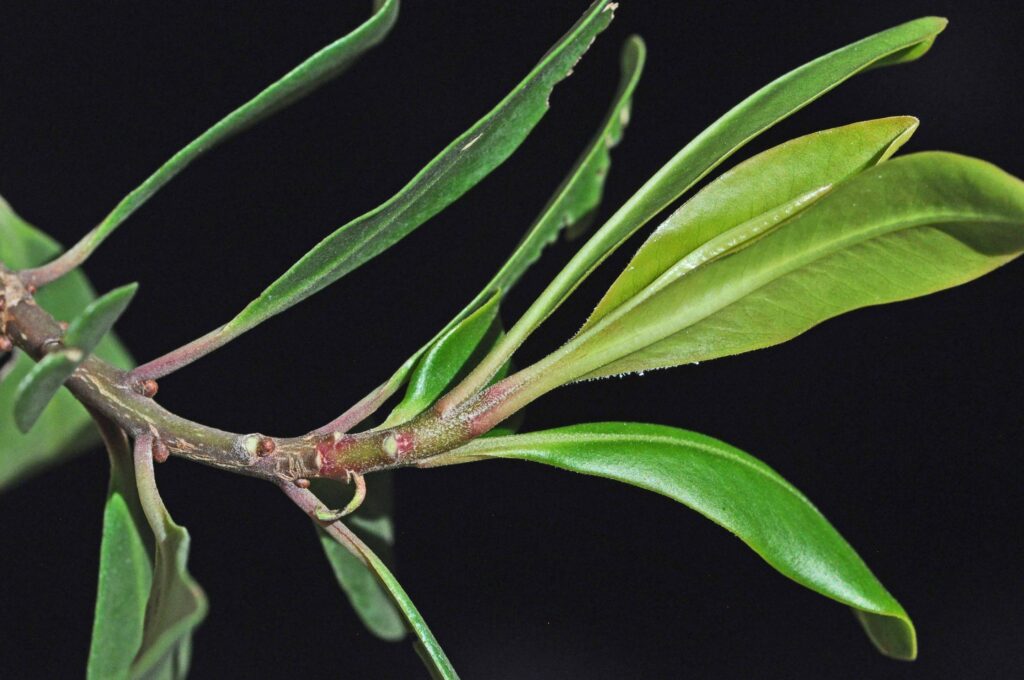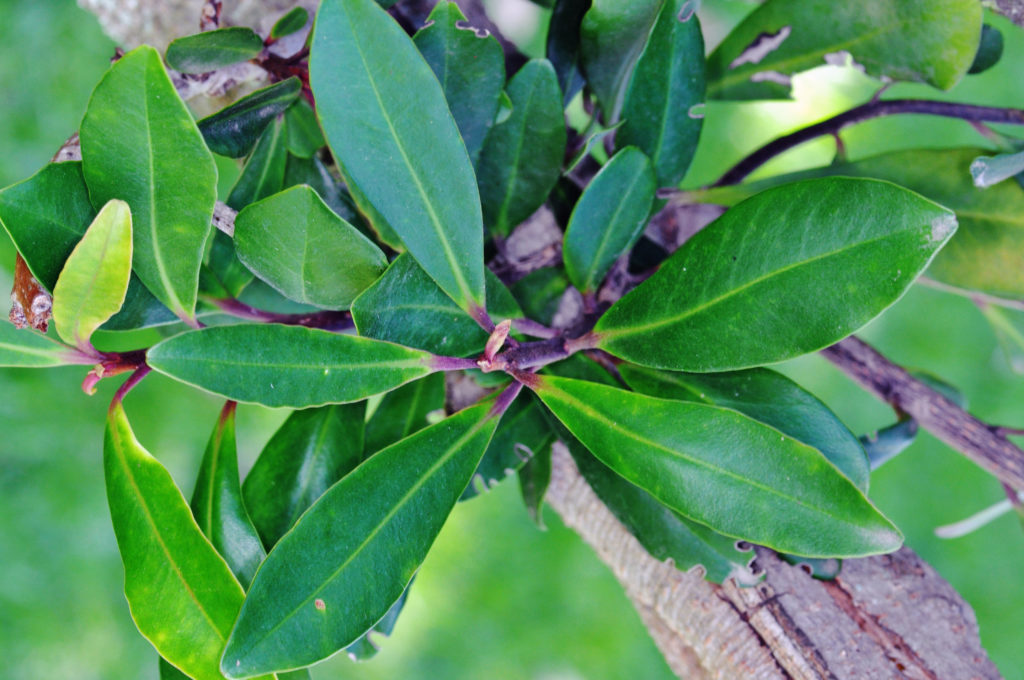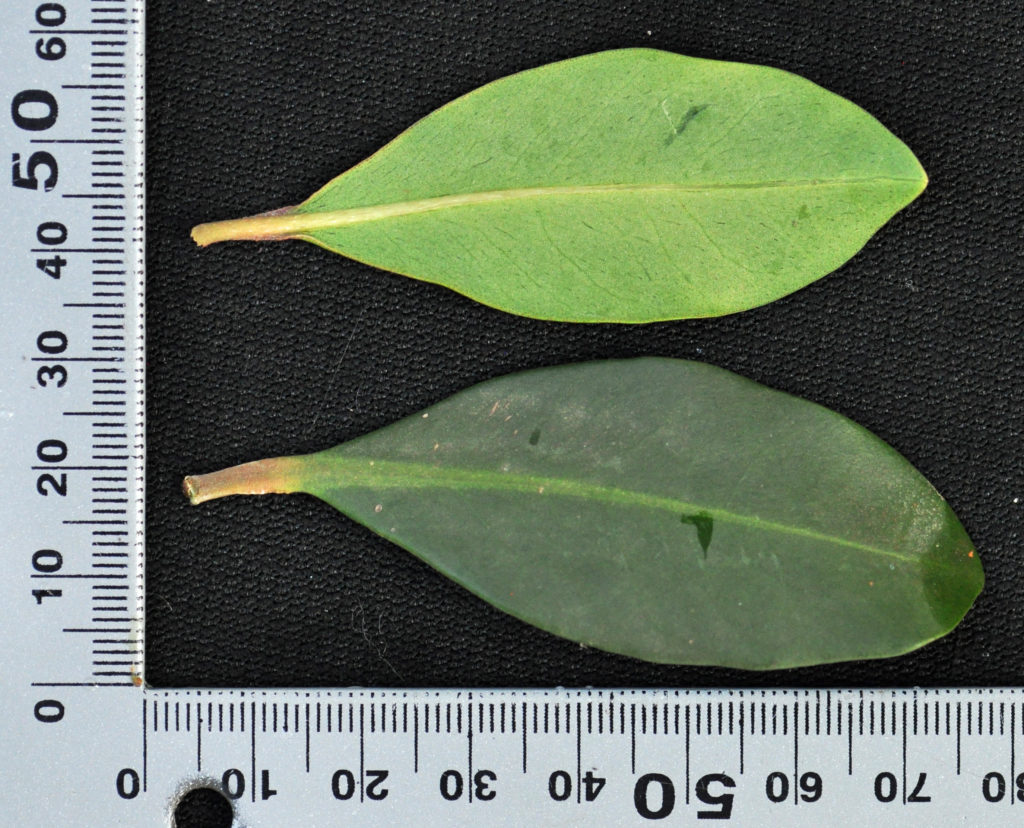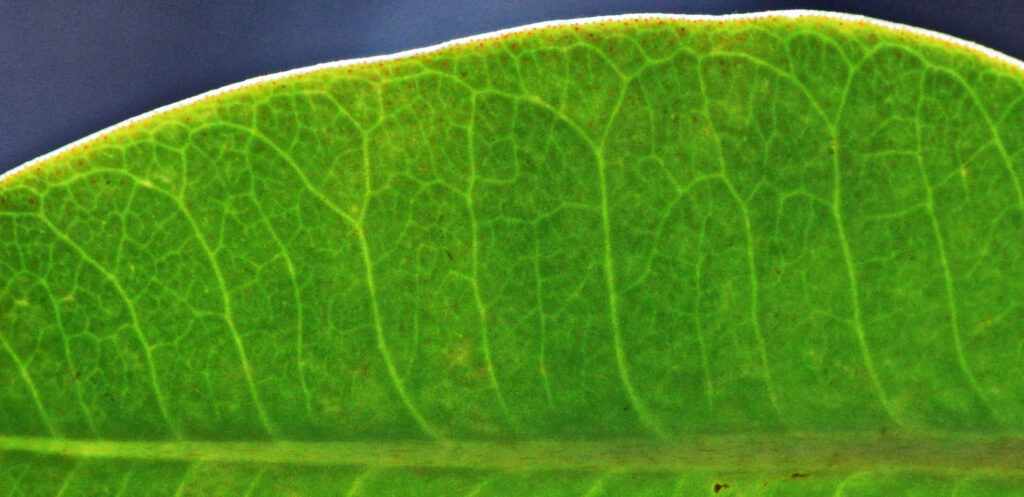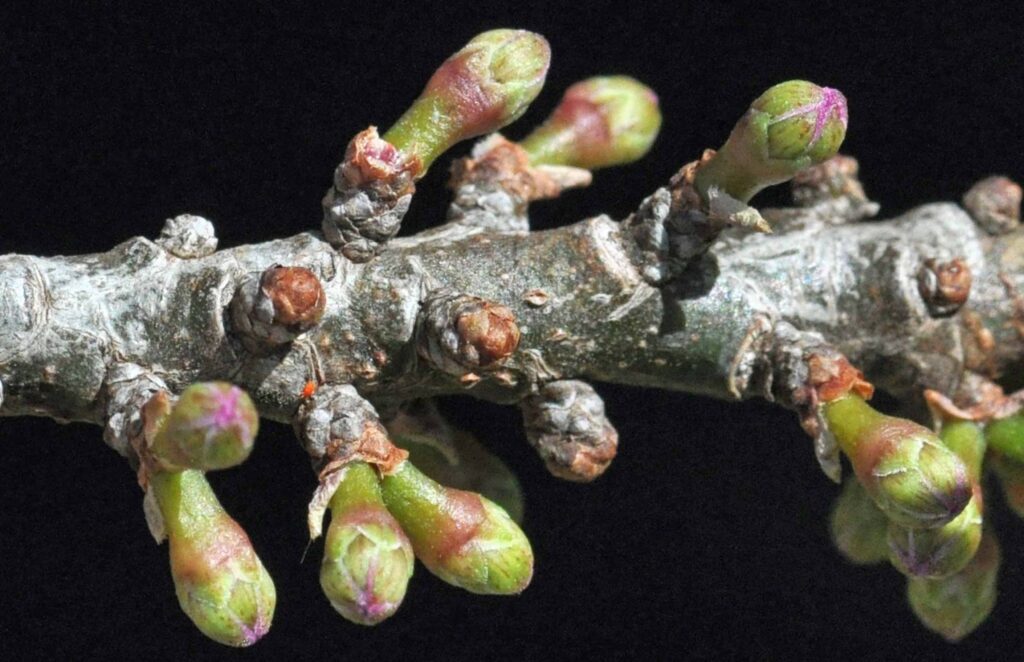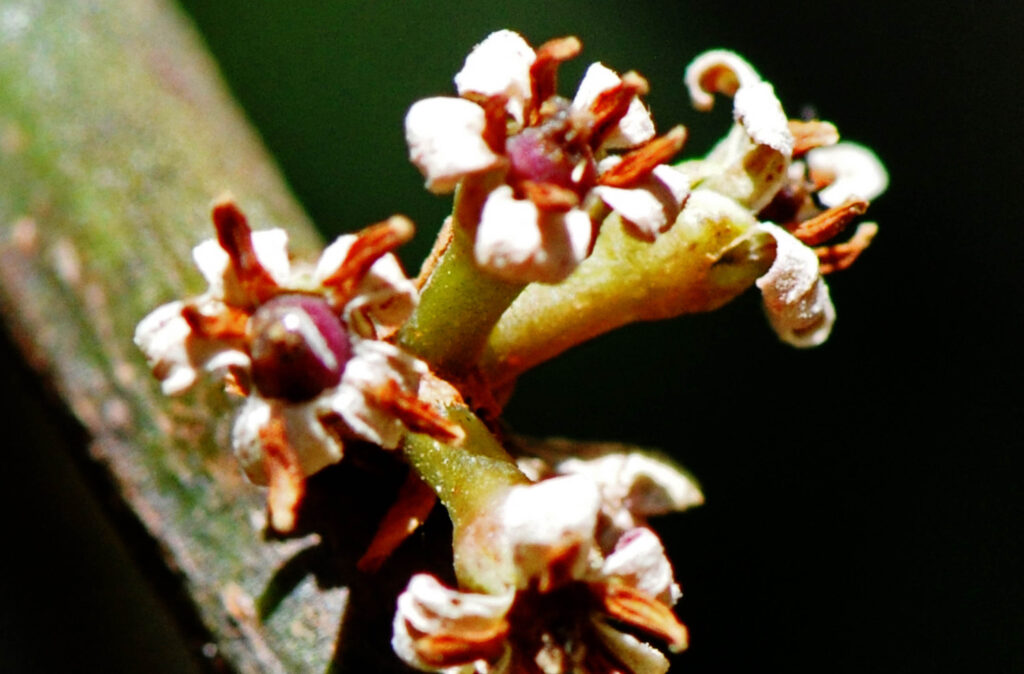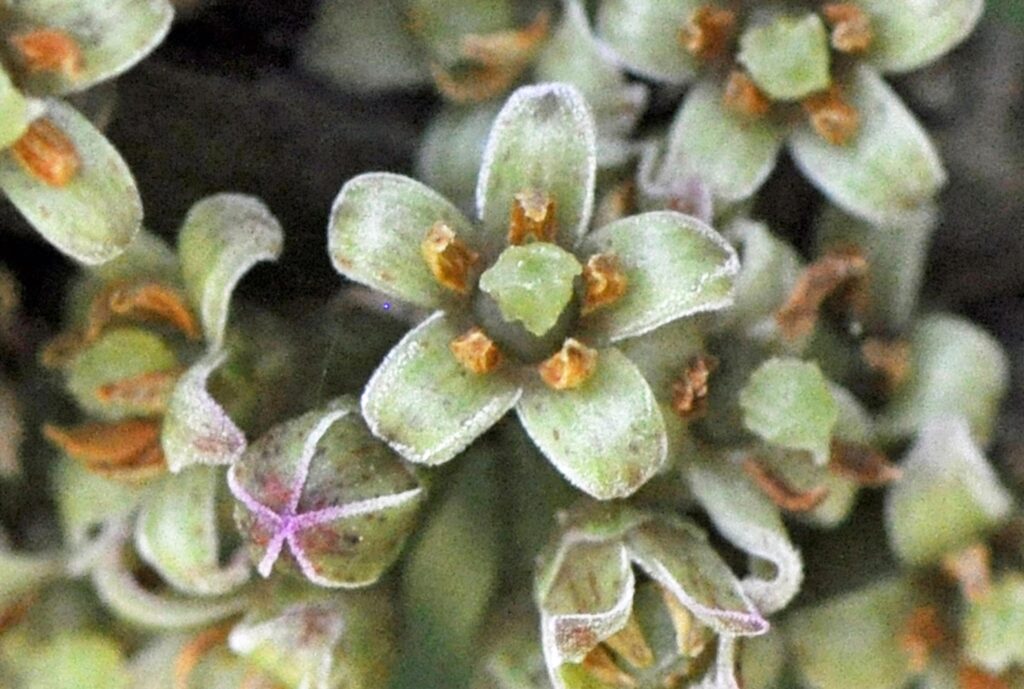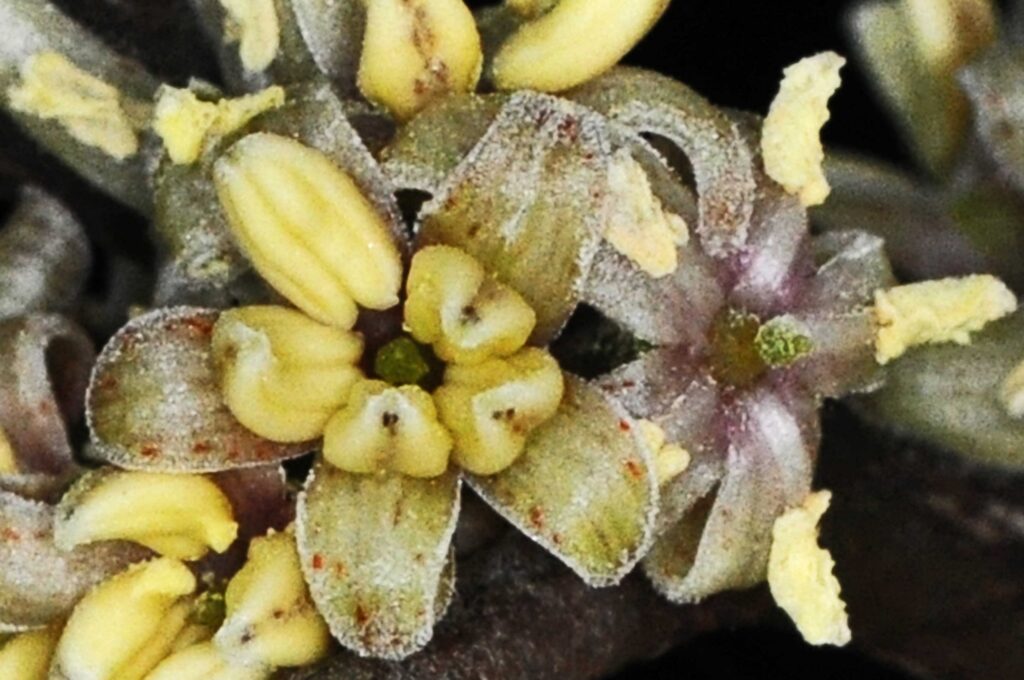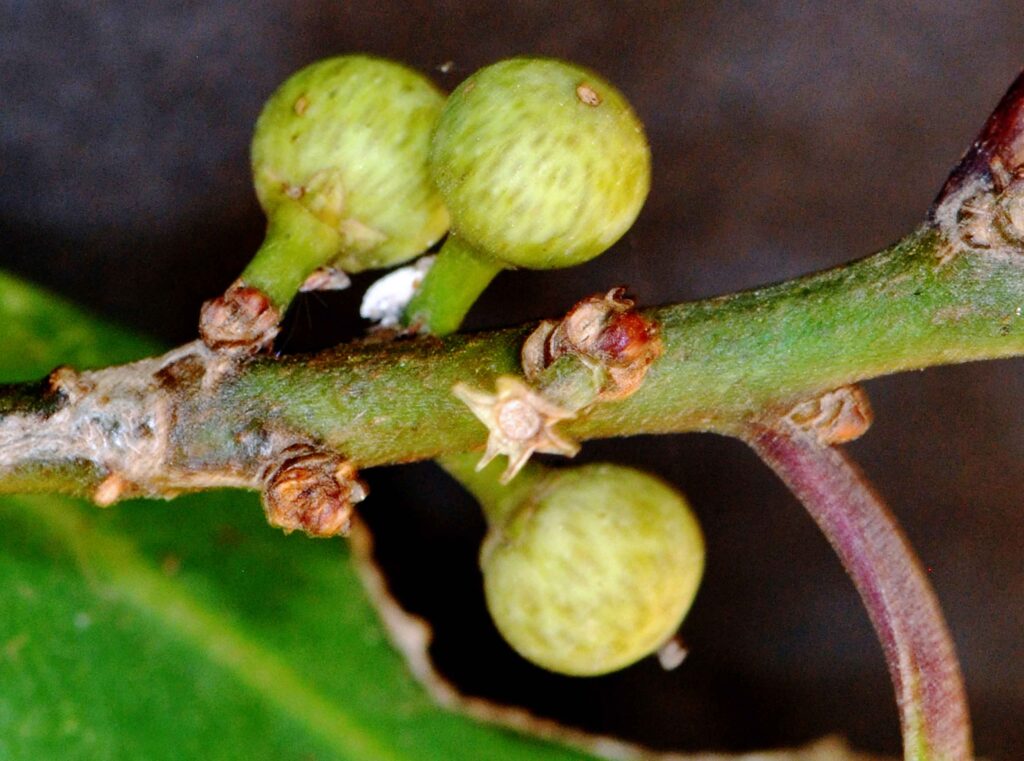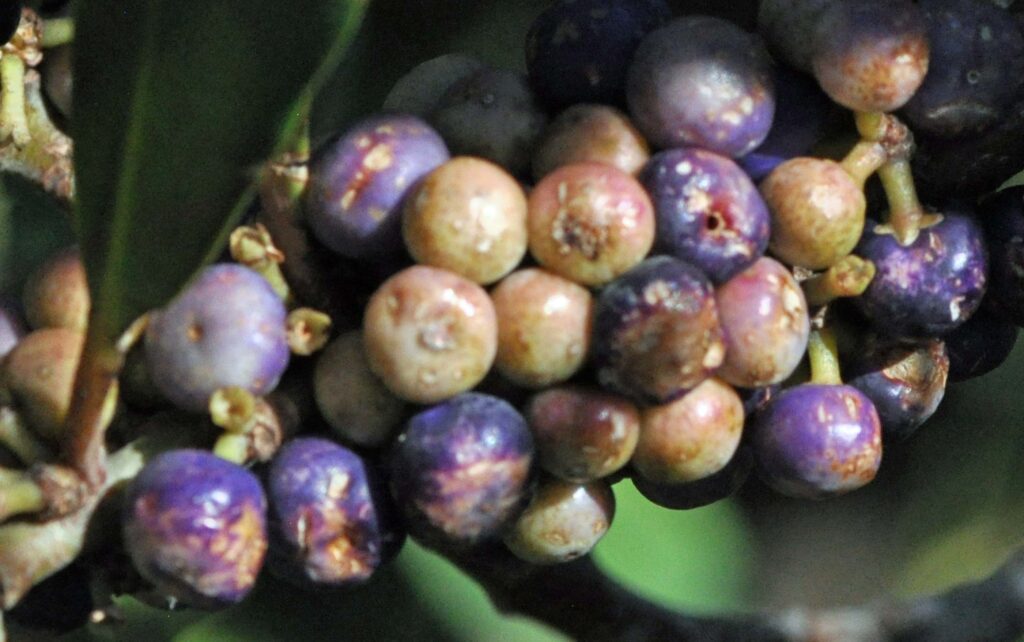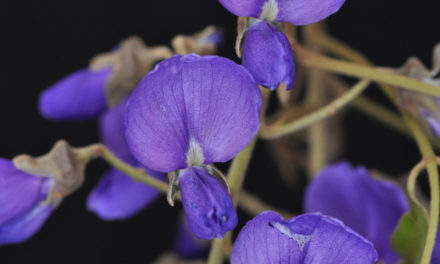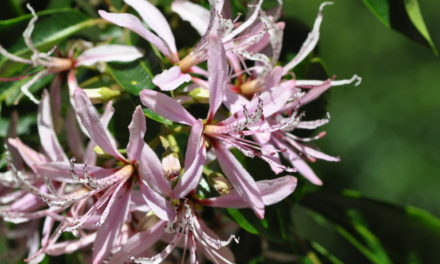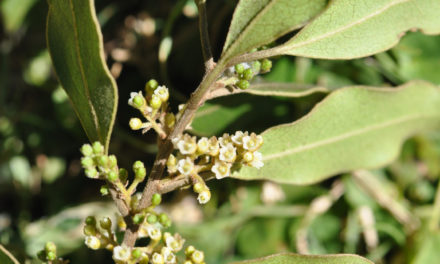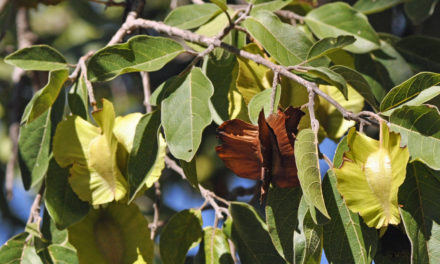General Info – summary
This evergreen Tree may reach 18m high. It may also be a bush. The simple Leaves have entire margins, are punctate, lack stipules and tend to develop at branch ends. The 5-merous regular & dioecious Flowers may arise on older wood. Stamens have large anthers that lack filaments. The pistil contains a superior ovary & short style. The Fruit is a single seeded, almost spherical, berry – maturing to a purple colour.
Description
Rapanea melanophloeos
Previous Names: Rapanea gracilior, Rapanea lamiaensis, Rapanea neurophylla, Rapanea pulchra, Rapanea runssorica, Rapanea rhododendroides, Rapanea schliebenii, Rapanea ulugurensis, Rapanea usambarensis, Rapanea umbratilis, Myrsine melanophloeos, Myrsine neurophylla, Myrsine rhododendroides, Sideroxylon melanophloeos.
SA Tree No. 578.
Common names: (Afr) Beukeboom, Beukehout, Boekehout, Boekenhout, Bucku-hout, Kaapse boekenhout, Roode Bucku, Rooiboekenhout, Rooi-bucku, Swartbas, Swartbasboom, Swartbas, Witbeukenhout, Witboekenhout. (Eng) Cape Beech, Cape Beech Tree, Roode Bucku. (isiXhosa) Isiqwandwemshube, Isiqwane Sehlathi. (isiZulu) Inhluthe, Isicalabi, Isihluthi-wentaba, Isiqalaba-sehlathi, Umaphipha, Umaphiphakhubalo, Umhluthi-wentaba, Uvukakwabafilikhubalo. (Northern Sotho) Mogônô. (siSwati) Gcolokhulu, Igcolo, ikhubakhula, Ikhubalwane, Ligcolo, Maphipha, Udzilidzile, Udzilidzili. (Tshivenda) Tshikonwa, Tshididiri. (Tsonga) Isihlwani, Shitsuvane.
Family: Myrsinaceae (Cape Beach family). Members can be trees, shrubs or lianas (a woody plant that climbs from the ground usually into trees). The simple Leaves lack stipules and are usually alternate. The small, regular Flowers are unisexual or bisexual. The Perianth has 4-5 sepals and petals. Stamens are opposite and equal to the number of petals. They are introrse and usually dehisce through longitudinal slits. The usually superior Ovary is unilocular and the style is simple. Fruit is an indehiscent drupe or berry. Seeds have copious endosperm (the starch and oil-containing tissue of many seeds; often referred to as the albumen). There are about 35 genera and about 1 000 species worldwide. In southern Africa, there are 4 genera and 7 species in the family. In South Africa, the family includes the 2 species in the genus Rapanea; R. melanophloeos (in this website) and the endangered R. gilliana.
Name derivation: Rapanea – meaning is unclear but may be the common name used for a species in Guinea. melanophloeos – dark or black bark.
Conservation: National Status: L C (Least concern). Assessment: 2016 (V.L. Williams, D. Raimondo, N.R. Crouch, A.B. Cunningham, C.R. Scott-Shaw, M. Lötter, A.M. Ngwenya and A.P. Dold). This plant is declining due to bark harvesting.
Tree
The straight, cylindrical trunk (photo 52 & 637) of this Tree, together with its branches, is usually up to 10m but may reach 20m high. It may also be a bush. Young Bark is greenish to light grey or light brown (photo 466). Smooth branches have Leaf scars and raised Lenticels (usually raised corky elongated areas on the plant that allows the uncontrolled interchange of gases with the environment (photo 500 – under Flowers). Young branches may be square in cross-section and are green, grey or reddish (photo 775). Here old pedicels (stalk from single flowers) may be visible (photo 224 under Fruit). Older bark becomes rough and here the bark is a darker brown and may be cracked into small squares. The bark contains tannin and often has lichen (composite organism arising from a mutualistic relationship between fungi or cyanobacteria and algae species) growing on it (photo 52). Large trunks are often furrowed.
- 92. 2014/09/23. Female. Walter Sisulu NBG. Photo: David Becking.
- 466. Male. 2014/12/09. Walter Sisulu NBG. Photo: David Becking.
- 52. 2016/05/17. Mount Shiba. Photo: David Becking.
- 637. 2016/08/23. Pretoria NBG. Photo: David Becking.
- 775. 2016/05/10. Walter Sisulu NBG. Photo: David Becking.
Leaves
This evergreen tree has shiny, thickly leathery and alternately or spirally arranged Leaves that tend to occur towards the ends of relatively thick branches. They become dark green above, lighter below and are glabrous (hairless). The leaves are simple (have a single blade which may have incisions that are not deep enough to divide the blade into leaflets – photo 893). Variable leaves are usually oblong to oblong-lanceolate and usually up to 12 x 5cm (photo 479). The mature Blade is punctate (with translucent or coloured dots, (photo 98 – just visible near the margin) depressions, or pits. The blade contains up to 22 pairs of lateral veins. Veins are easier to see when observed against a strong light (photo 98). Here the veins loop together prior to reaching the margin. The Apex (photo 893) is broadly tapering to rounded and occasionally notched. The Base is cuneate (narrowly triangular with an acute angle towards the base). If a leaf is broken off at the base, a brown liquid is exuded. The Midrib is pale, visible on both sides and protrudes below (photo 479). The rolled under, thickened Margin may be wavy and is entire (with a continuous margin, not in any way indented) and slightly decurrent (the leaf blade extends down the petiole towards the stem – photo 479). Each Petioles (leaf stalk) is up to 1,5+cm long and yellow or purplish red (photo 893). If a leaf is broken off the stem at the petiole, a brown liquid oozes out. Stipules (basal appendages of the petiole) are absent. Brown Sap is present.
- 503. 2019/09/04. Walter Sisulu NBG. Photo: David Becking.
- 893. 2014/03/25. Walter Sisulu NBG. Photo: David Becking.
- 479. 2016/11/15. Pretoria NBG. Photo: David Becking.
- 98. 2017/09/19. Pretoria NBG. Photo: David Becking.
Flowers
These unremarkable small (up to 8mm) wide Flowers are actinomorphic (divisible vertically into similar halves by more than 1 plane passing through the axis) and Dioecious (unisexual floral structures with functional male and female parts on separate plants – photos 92 & 466 under Tree). They may be greenish, whitish or pink and arranged in few-flowered clusters in leaf axils or below leaf scars or on older wood (photos 500 & 91). Sepals are joined at the base of the Calyx (photo 500) which may remain attached to the Pedicel (flower stalk) after the fruit has fallen – photo 244 under Fruit). The Corolla has 5 Petals that are longer than the sepals and fused into a tube at the base (photo 91). The five Stamens lack Filaments and arise in the throat of the corolla (photo 326). The relatively large Anthers (photo 326) dehisce through slits. They occur opposite the petals. Staminodes (sterile stamens) may be present (photo 332 & 91). There is a single Pistil (a unit of the Gynoecium, the female element of the flower, composed of the Ovary, Style and Stigma) with a superior, sessile Ovary that has a short, thick Style. This ends in a variable shaped Stigma (photo 322). The main pollination agents are bees and flies. (May-Jul … Dec).
- 500. 2019/09/04. Walter Sisulu NBG. Photo: David Becking.
- 91. 2014/09/23. Female. Walter Sisulu NBG. Photo: David Becking.
- 322. 2015/09/15. Walter Sisulu NBG. Photo: David Becking.
- 326. 2015/09/15. Male: Walter Sisulu NBG. Photo: David Becking.
Fruit
The thinly fleshy, 1-seeded Fruit is an almost spherical Berry (pulpy, indehiscent fruit like a grape or tomato), which is up to 8mm in diameter. These berries are initially green but change to white, pink and finally purple (photo 341). The remains of the Calyx may still be attached to the Pedicel (flower stalk) – after the fruit has fallen (photo 244). On this photo, the young fruit and the apical remains of the stigma and style are visible. Fruit has a hard Endocarp (the inner layer of the pericarp or fruit wall) and sits on a pedicel of varying lengths. These berries occur along the branchlets, below the leaves. Flowers and fruit may occur simultaneously (Jun-Dec). The fruit takes about 3 months to mature. On a slightly older stem, each mature fruit rests on a short pedicel and contains a single Seed.
- 244. 2014/10/07. Walter Sisulu NBG. Photo: David Becking.
- 341. 2018/09/11. Kirstenbosch NBG. Photo: David Becking.
Distribution & Ecology
This plant is widely Distributed, from the Western Cape – including Table Mountain, Eastern Cape, up the East coast and escarpment e.g., at Royal Natal National Park and the high wet rainfall in Nkandal Forest (about 56km NW of Eshowe), through the high mountainous western Swaziland, Zimbabwe, Mozambique into Zambia and Malawi. It often occurs in damp areas in kloofs and gullies and is tolerant of strong winds. It survives well at the coast, in rocky areas and even in swampy areas, but does require a fair amount of light. As a common pioneer bush, it is found in, or adjacent to forests as well as exposed mountains. Naturally occurring trees, grow from sea level (even in relatively dry areas) to an altitude to at least 1 700m. Elephants consume the Leaves. Animals such as birds, monkeys, wild pigs and baboons eat the Fruit. In the process the Seeds are dispersed. Flowers attract bees and flies. A serious stem canker disease caused by a previously unknown fungus Immersiporthe knoxdaviesiana has recently been discovered on the stems of some of these trees in the Western Cape.
Ethnobotany
The Bark has been used for tanning. The very attractive hard Wood makes excellent furniture and has a net-like grain. The wood is dense (wet: 1 150kg per cubic metre and dry 735/785kg per cubic metre). As a result, wet wood will sink in fresh water and dry wood will float. It is whitish when sawn and changes to dull pinkish-brown as it dries. It should be kiln dried for best effect. At this stage, it polishes well. It may be difficult to season and may split in the central part. Wood resembles that from the genus Faurea (in the family Proteaceae). Wood saws easily, turns well and is used for the manufacture of violin backs, drumsticks, organ pipes, furniture and even panga handles. It is grown as an ornamental and a screening tree. New plants can develop from root suckers. Roots may be a problem and trees need to be planted away from buildings or paving. The plant, especially the bark, is widely used in local medicine. The tree grows well from Seeds. A recent study apparently supports the medicinal use of this plant in managing blood clotting related diseases. Another source indicates that it may be of beneficial use against bilharzia. The larvae of the southern African Emperor Moth (Nudaurelia cytherea) consume the leaves of this and other trees. The large larvae (up to 12cm long) are a valuable protein source to local people. These larvae cause a problem in pine plantations.
References
Boon, R. 2010. Pooley’s Trees of eastern South Africa. Flora and Fauna Publications Trust, Durban.
Burrows, J.E., Burrows, S.M., Lotter, M.C. & Schmidt, E. 2018. Trees and Shrubs Mozambique. Publishing Print Matters (Pty) Ltd. Noordhoek, Cape Town.
Coates Palgrave, M. 2002. Keith Coates Palgrave Trees of Southern Africa, edn 3. Struik, Cape Town.
Lawrence, G. H. M, 1951. Taxonomy of Vascular Plants. The Macmillan Company, New York. Tenth Printing 1965.
Palmer, E. & Pitman, N. 1972. Trees of southern Africa. Balkema, Amsterdam, Cape Town.
Schmidt, S. Lotter, M. & McCleland, W. 2002. Trees and Shrubs of Mpumalanga and the Kruger National Park. Jacana, Johannesburg.
van Wyk, B. & van Wyk, P. 1997 Field guide to Trees of Southern Africa. Struik, Cape Town.
Williams, V.L., Raimondo, D., Crouch, N.R., Cunningham, A.B., Scott-Shaw, C.R., Lötter, M., Ngwenya, A.M. & Dold, A.P. 2016. Rapanea melanophloeos (L.) Mez. National Assessment: Red List of South African Plants version 2020.1. Accessed on 2023/11/03.
https://en.wikipedia.org/wiki/Rapanea_melanophloeos
http://plantzafrica.com/plantqrs/rapanmelan.htm
http://www.woodmans.co.za/timber/capebeech.html
http://www.zimbabweflora.co.zw/speciesdata/species.php?species_id=143560
https://www.researchgate.net/publication/235574981_PROTA_72_Timbers_2_Myrsine_melanophloeos
http://uzspace.uzulu.ac.za/bitstream/handle/10530/617/anti-placet%20aggregation%20of%20rapanea%20melanophloespdf?sequence=1
http://repository.up.ac.za/bitstream/handle/2263/31750/Chen_Serious_2013.pdf?sequence=1
http://www.labome.org/research/Rapanea-melanophloeos-leaf-extracts-against-Schistosoma-mansoni-miracidia.html
http://posa.sanbi.org/flora/browse.php?src=SP

